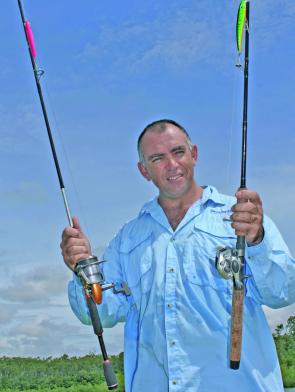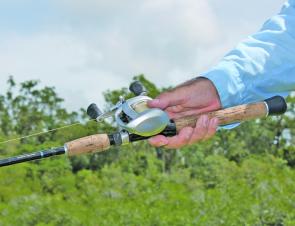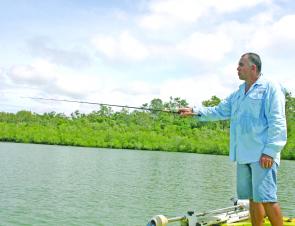Last month we looked at the casting accuracy of threadline reels. For finesse fishing or working lures vertically in deepwater the threadline is an awesome reel, but for accurately casting large hardbodies or for fishing with heavy braided line, small baitcasters are in a league of their own.
Baitcasters are popular with northern anglers due to the use of heavier line class on small rods. Casting the same lures on a threadline is a little more difficult because the thicker line causes a lot more friction when casting so distance and accuracy are compromised.
The drag systems can be put under a lot of stress when heavy line is being used on small baitcasting tackle and, while expensive top shelf threadlines have brilliant drag systems, quality baitcasters are a lot more affordable and most have great drags in them.
Having a balanced outfit is vital so talk to your tackle store sales rep about the fish you wish to target and line class that you will be using. There is also a huge difference between a $100 reel and a $300 reel so buy the best you can afford.
I also love the fact that I can work a baitcaster with my thumb over the spool so when a big bass heads back into the timber or a barra dives for his snag. The thumb can lock down on the spool and a lot more pressure can be applied to pull the fish out. You win some and you loose some but if the fish gets back into cover it is all over, so having that sort of control is great.
A lot of anglers shy away from baitcasters because they can be hard to cast and the dreaded backlash can often occur while learning the ropes. The secret to controlling a baitcaster is being able to balance the speed of the spool with the speed of the lure or bait.
Start with the casting control systems on the reel itself and adjust them to suit the conditions, casting weight and skill level. Some reels use magnets that need to be engaged or disengaged to help control the speed of the reel while others have a dial. When starting out, dial the control up to 10 or as high as it goes, or for magnet reels engage all the magnets. You will lose casting distance but have more control and as you get better, you start loosening off the control system.
There is also a dial that controls the tension on the bearing of the reel. There are different opinions about how this should be set so for what it’s worth, I like to set my bearing tension so that when the spool is unlocked and ready to cast, the lure or rig falls under a steady, controlled speed. If you disengage the spool and the lure plummets like a stone, the bearing is too loose and by the same token, if it doesn’t fall at all it is too tight.
When the reel is dialled in, hold it in a comfortable position and have the thumb ready on the spool. Once the spool is disengaged, thumb pressure is all that is stopping the bait or lure from falling. When you make the cast, release the thumb pressure at the precise moment to achieve the cast. It is vital that the cast be smooth with no jerky, flicky movements. You can load up the rod and give it a good, strong cast as long as you keep it smooth.
Never take your thumb completely off the spool. During that cast, your thumb should be able to feel the spool spinning under it and the second that the lure hits the water, your thumb needs to lock down on the spool to stop any over-runs that cause birds nests.
Problems can arise from casting into the wind. It slows the lure down too much but the spool will also keep spinning, causing an over-run. By training your thumb to feel for loose line coming from the spool while the lure is in mid air can avoid all these problems. Once a little loose line is felt, the thumb can apply a tiny bit of pressure to slow the spool a little and control the cast.
Birds nests from over-runs happen to the best of us from time to time and after many years of casting baitcasters, I have learnt a thing or two about getting them out. The best advice that I received was to pull the line back towards the butt of the rod. This helps to stop pulling little knots tight. Digging away and picking out the loops will get it sorted out more often then not and after recently teaching my 11 year old son to use a baitcaster, I have unpicked some cracker bird nests.
Facts
Three Easy Steps to cast like a pro:
• Step one
Check that the side bearing has a pre-load that is adequate for the weight of the lure and that the casting control dial or weights have been set according to your skill level.
• Step two
With a comfortable grip and thumb on the spool, load up the rod and in a smooth motion cast the lure.
• Step three
Keeping very light pressure on the spool, control any over-runs during the cast and remember to lock down on the spool as soon as the lure arrives at its destination and you’re done.

Baitcasting tackle is the preferred tackle to use when casting bigger lures for tropical species like barra and jacks.

Threadline tackle can be used but bigger lures and bigger fish make the job hard and reduce your casting accuracy.

The choice of which outfit you use is personal, but when it comes to casting accurately with bigger lures, the baitcaster has no peer.

It’s important to have your rod and reel sit comfortably in your hand. Most anglers tends to hold the rod on a slight angle like this. If you imagine you are shaking hands with your outfit, then you will find a natural angle and this is how you should cas

Casting with a baitcaster involves the wrist more than the arm. Casting with your wrist means there is less margin for error as the rod tip will not deviate far from the vertical plane.

Keep your thumb on the spool for the entire cast. This helps slow the spool during the cast reducing the chance of a backlash and also allows the angler to stop the flight of the lure instantly if it’s heading into trouble.




